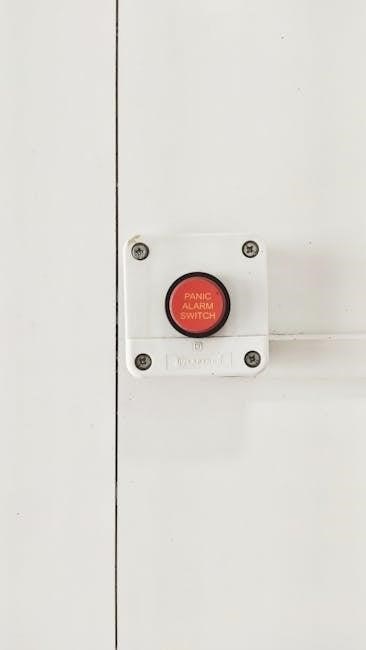
inkbird controller manual
Inkbird controllers are easy-to-use, safe, and reliable devices designed for precise temperature and humidity control. They offer dual relay outputs for versatile applications, ensuring efficient and consistent performance.
1.1 Overview of Inkbird Controllers
Inkbird controllers are versatile, efficient, and user-friendly devices designed for precise temperature and humidity management. They feature dual relay outputs, enabling control of both heating and cooling systems. These controllers are ideal for various applications, including homebrewing, cooking, and reptile habitats. With their intuitive interface and advanced PID control, Inkbird controllers ensure stable and accurate environmental conditions. They are also equipped with safety features like overheat protection, making them reliable for long-term use. Inkbird controllers are widely used for their durability and ease of integration into different systems.
1.2 Importance of the User Manual
The user manual is essential for unlocking the full potential of Inkbird controllers. It provides step-by-step instructions for setup, operation, and troubleshooting, ensuring users can configure their devices correctly. The manual contains detailed information on PID tuning, self-tuning modes, and safety precautions. By following the guidelines, users can optimize performance, prevent errors, and extend the lifespan of their controllers. Referencing the manual is crucial for understanding advanced features and resolving common issues, making it an indispensable resource for both beginners and experienced users.
Technical Specifications
Inkbird controllers feature dual relay outputs, precise temperature control, and compatibility with various applications. They support wide temperature ranges and humidity monitoring, ensuring efficient and reliable performance across setups.
2.1 Key Features of Inkbird Controllers
Inkbird controllers are equipped with dual relay outputs for precise temperature and humidity control. They feature PID control with self-tuning modes for optimal performance. Wi-Fi connectivity enables remote monitoring and adjustments via smartphones. Programmable temperature profiles allow for customized settings across various applications. The controllers support wide temperature ranges and are designed for safe, reliable operation in brewing, cooking, and other precise control environments. Their user-friendly interfaces and robust construction ensure durability and ease of use, making them versatile tools for both home and professional settings.
2.2 Temperature and Humidity Ranges
Inkbird controllers offer wide temperature ranges, typically from -40°C to 100°C, and humidity ranges from 5% to 99% RH. These broad ranges ensure versatility across applications like brewing, cooking, and environmental control. The controllers maintain precise accuracy, essential for sensitive processes. Dual relay outputs allow for independent control of heating and cooling systems. This flexibility makes Inkbird controllers suitable for both home and industrial use, providing consistent and reliable performance in various settings. Their adaptability ensures they meet diverse user needs effectively.

Installation and Setup
Install your Inkbird controller by connecting sensors and relays, then power it up. Ensure proper placement and follow manual guidelines for a smooth setup experience.
3.1 Unboxing and Initial Setup
Upon unboxing your Inkbird controller, ensure all components are included: the controller unit, temperature and humidity sensors, power adapter, and user manual. Place the controller in a well-ventilated area, away from direct sunlight. Connect the sensors to their respective ports, ensuring secure fittings. Plug in the power adapter and turn on the device. The LCD screen will display initial settings. Follow the manual to configure basic parameters, such as temperature units and relay settings, to prepare the controller for operation.
3.2 Connecting Sensors and Relays
Begin by identifying the sensor and relay ports on the controller; Gently connect the temperature and humidity sensors to their designated inputs, ensuring secure and firm connections. Next, attach the relay wires to the appropriate output terminals, matching the controller’s configuration. Double-check the wiring to prevent short circuits or misconnections. Once all sensors and relays are connected, power on the controller and verify that the sensors detect accurate readings. This step ensures proper communication between components for reliable operation.
3.3 Powering the Controller
To power the Inkbird controller, connect it to a compatible power supply (typically 12V or 24V DC). Ensure the voltage matches the controller’s specifications to avoid damage. Plug the adapter into a grounded electrical outlet for safety. Avoid using low-quality power sources, as they may cause instability. Once powered, the controller will initialize, and the LED indicators will light up to confirm proper operation. Always follow the manual’s guidelines to prevent overloading or electrical hazards. Proper power connection is essential for reliable performance and longevity of the device.
Basic Operations
Inkbird controllers offer straightforward operation with an intuitive interface. Users can easily navigate, set parameters, and monitor real-time data. LED indicators provide clear status updates, ensuring seamless control and efficiency.
4.1 Navigating the Control Panel
Navigating the Inkbird controller’s control panel is straightforward. The interface features an LCD display and buttons for easy menu access. Press and hold the SET key to enter settings, while the arrow keys adjust values. The display shows real-time temperature, humidity, and relay status. LEDs indicate active outputs and alarm conditions. The menu is divided into sections for temperature, humidity, and relay settings, ensuring quick access to desired functions. This intuitive design allows users to configure and monitor their system efficiently, even for those new to temperature control systems.
4.2 Setting Temperature and Humidity Levels
Setting temperature and humidity levels on your Inkbird controller is a seamless process. Use the arrow keys to adjust the desired temperature or humidity value displayed on the LCD screen. The controller allows you to set specific ranges, ensuring precise control. For temperature, press the up or down arrow to reach your target value, then confirm with the SET button. Humidity levels can be adjusted similarly, with options to enable or disable humidity control. Advanced models may offer PID control for optimized stability, while others provide self-tuning modes for hassle-free calibration, ensuring consistent and accurate results tailored to your needs.
4.3 Understanding LED Indicators
The LED indicators on your Inkbird controller provide real-time status updates. The power LED indicates the device is operational, while the relay LEDs (typically labeled HEAT and COOL) show when heating or cooling outputs are active. Additional LEDs may indicate Wi-Fi connectivity or alarm statuses. These visual cues help monitor system performance and troubleshoot issues efficiently. Refer to the user manual for specific LED functions, ensuring optimal operation and quick identification of any operational changes or potential issues, thus enhancing your control experience.

PID Control and Tuning
PID control ensures precise temperature regulation by adjusting proportional, integral, and derivative values. It maintains stability and accuracy, crucial for sensitive applications like brewing or reptile habitats.
5.1 What is PID Control?
PID (Proportional-Integral-Derivative) control is a precise method for regulating temperature and humidity. It uses proportional, integral, and derivative values to minimize errors and stabilize output. The proportional term adjusts based on current error, the integral term corrects long-term errors, and the derivative term anticipates future errors. This ensures accurate and stable control, essential for applications like brewing, reptile habitats, and fermentation. Inkbird controllers feature PID control as a default setting, with options for self-tuning to optimize performance in varying environments.
5.2 Tuning PID Parameters
Tuning PID parameters is crucial for optimal controller performance. Start with default settings for stability, then adjust based on system response. Increase proportional gain for faster responses but avoid oscillations. Adjust integral time to eliminate steady-state error. Derivative time helps reduce overshooting. Use the self-tuning mode for automatic optimization. Fine-tune manually if needed, ensuring smooth and accurate temperature control. Regular adjustments may be necessary for changing conditions, ensuring consistent and reliable operation across various applications.
5.3 Self-Tuning Mode Explained
The self-tuning mode automatically adjusts PID parameters for optimal performance. It analyzes system behavior, identifying response times and oscillations. This mode is ideal for users without prior PID tuning experience. Once activated, the controller gradually adjusts settings to stabilize temperature control. It ensures precise and efficient operation by minimizing errors and overshooting. Self-tuning is recommended during initial setup or when operating conditions change, providing a hassle-free solution for achieving consistent and accurate temperature management.
Advanced Features
Inkbird controllers offer advanced features like Wi-Fi connectivity for remote monitoring, programmable temperature profiles for precise control, and dual relay functionality for versatile applications in brewing, BBQ, and more.
6.1 Wi-Fi Connectivity and Remote Monitoring
Inkbird controllers feature Wi-Fi connectivity, enabling remote monitoring and control via smartphones. Users can adjust settings, monitor temperatures, and receive alerts through dedicated apps. This advanced functionality enhances convenience, allowing seamless management of brewing, BBQ, or other applications from anywhere. Wi-Fi setup is straightforward, ensuring a stable connection for real-time data access and control, making it ideal for both home and professional use. This feature ensures precise temperature management without physical presence, optimizing efficiency and ease of use for all users.
6.2 Programmable Temperature Profiles
Inkbird controllers allow users to create programmable temperature profiles, enabling precise control over temperature changes at specific times. This feature is ideal for processes like brewing or cooking, where consistent temperature transitions are crucial. By setting multiple temperature points, users can automate their control process, ensuring accuracy and efficiency. The controller executes these profiles seamlessly, switching relays as needed to maintain the desired conditions. This functionality enhances flexibility and consistency, making it perfect for advanced applications requiring tailored temperature management.
6.3 Dual Relay Output Functionality
The Inkbird controller features dual relay outputs, providing flexible control over two independent devices, such as heaters and coolers. This allows for precise temperature management in applications like homebrewing or reptile enclosures. Each relay can be programmed to activate based on temperature readings, ensuring optimal conditions. The dual relay setup enhances efficiency and versatility, enabling users to maintain multiple outputs simultaneously. Safety precautions, such as avoiding overload, are essential to ensure reliable operation. This feature makes the controller adaptable for various advanced temperature control needs.
Safety Precautions
Ensure safe operation by avoiding overload and following installation guidelines. Never exceed power limits or use with heaters and humidifiers over 1200W (120V) or 2200W (220V).
7.1 Overheat Protection
Inkbird controllers feature overheat protection to prevent damage from excessive temperatures. If the temperature exceeds safe levels, the controller activates cooling systems or disconnects heaters. Ensure devices connected do not surpass 1200W (120V) or 2200W (220V). Regularly inspect sensors and maintain proper ventilation to avoid overheating. Never expose the controller to direct sunlight or high-humidity environments. Adhere to these guidelines to ensure safe and reliable operation, protecting both the controller and connected equipment from potential damage.
7.2 Safe Usage Guidelines
Always follow Inkbird controller guidelines to ensure safe operation. Avoid exposing the device to water or extreme humidity. Keep it away from direct sunlight and flammable materials. Do not exceed the recommended power limits for connected devices. Regularly inspect sensors and connections for damage. Ensure proper ventilation and avoid overheating situations. By adhering to these guidelines, you can maintain optimal performance and longevity of your Inkbird controller while ensuring a safe operating environment for all connected equipment.

Troubleshooting Common Issues
Troubleshoot common issues by checking sensor connections, ensuring proper calibration, and verifying relay functionality. Reset the controller if it fails to respond or displays errors unexpectedly.
8.1 Identifying and Solving Connection Problems
Connection issues often arise from loose wires or incorrect sensor placement. Verify that all sensors and relays are securely connected to the controller. Check for any damage or corrosion on the wires. Ensure the controller is properly powered and that all cables are compatible. If the issue persists, reset the controller by holding the reset button for 5 seconds. Consult the user manual for detailed troubleshooting steps or contact Inkbird support for further assistance.
8.2 Addressing Temperature Deviations
Temperature deviations can occur due to sensor calibration issues or PID parameter settings. First, ensure sensors are clean and placed correctly. If deviations persist, recalibrate the sensors as outlined in the manual. Adjust PID parameters for accurate temperature control. If using self-tuning mode, allow the controller to stabilize before making adjustments. Regularly check for firmware updates to ensure optimal performance. Refer to the troubleshooting section for detailed guidance on resolving temperature-related issues.
8.3 Resetting the Controller
Resetting the Inkbird controller restores factory settings, resolving persistent issues. Press and hold the SET button for 5 seconds to initiate a reset. This clears all customized settings, so reconfiguration is necessary. Use this feature cautiously and only when needed. For detailed reset instructions, refer to the user manual. Ensure proper setup after resetting to maintain optimal performance and accuracy in temperature control. Regular resets are not typically required unless experiencing recurring operational issues. Always follow the manual’s guidance for a successful reset process.

Maintenance and Care
Regularly clean the controller with a soft cloth and avoid harsh chemicals. Calibrate sensors periodically for accuracy and update firmware to ensure optimal performance and reliability.
9.1 Cleaning the Controller
Regular cleaning ensures optimal performance and longevity of your Inkbird controller. Use a soft, dry cloth to wipe the exterior, avoiding harsh chemicals or abrasive materials. For tougher stains, lightly dampen the cloth with water, but ensure no moisture seeps into openings. Avoid spraying liquids directly on the device. Clean the display and buttons gently to maintain responsiveness. Unplug the controller before cleaning to prevent electrical issues. Regular maintenance helps preserve functionality and accuracy, ensuring reliable temperature and humidity control.
9.2 Calibrating Sensors
Calibrating your Inkbird controller’s sensors ensures accurate temperature and humidity readings. Start by accessing the calibration menu via the control panel. Use a reference thermometer or hygrometer to compare readings. Adjust the offset values in the menu to match the reference device. Save settings after calibration. Regular calibration is crucial for maintaining precision, especially in critical applications like brewing or reptile habitats. Refer to the user manual for specific calibration steps tailored to your model, ensuring optimal performance and reliability in your control system.
9.3 Updating Firmware
Updating the firmware on your Inkbird controller ensures you have the latest features and performance improvements. Visit the official Inkbird website to download the correct firmware version for your model. Connect your controller to a computer using a USB cable and follow the on-screen instructions to complete the update. Avoid interrupting the process to prevent potential issues. Once updated, your controller will operate with enhanced functionality and efficiency; Always refer to the user manual for specific guidance on updating firmware for your particular Inkbird model.
Warranty and Support
Inkbird controllers are backed by a 2-year warranty, with temperature and humidity probes covered for 1 year. Contact Inkbird support for assistance or warranty claims.
10.1 Warranty Coverage Details
Inkbird controllers are covered by a 2-year warranty from the date of purchase, while temperature and humidity probes are covered for 1 year. The warranty applies under normal operating conditions and requires proof of purchase. Damage caused by misuse, improper installation, or external factors is not covered. For warranty claims, contact Inkbird support with your purchase details and a description of the issue. The warranty ensures defective products are repaired or replaced, providing peace of mind for users relying on precise temperature control solutions.
10.2 Contacting Inkbird Support
For assistance with your Inkbird controller, visit the official website at www.ink-bird.com and navigate to the support section. Contact their team via email at support@ink-bird.com for troubleshooting, warranty inquiries, or general questions. Include your product model, purchase details, and a clear description of the issue. Ensure the subject line includes your product model (e.g., “ITC-308 Support Inquiry”). Their dedicated team aims to provide prompt and effective solutions to ensure optimal performance of your temperature control system.

Frequently Asked Questions (FAQs)
Discover solutions to common queries about setup, features, and troubleshooting. Explore FAQs for quick answers to enhance your Inkbird controller experience and resolve issues efficiently.
11.1 Common User Queries
Users often inquire about initial setup, PID tuning, and Wi-Fi connectivity issues. Common questions include troubleshooting temperature deviations, understanding LED indicators, and resetting the controller. Many seek guidance on programmable profiles and relay functionality. Others ask about compatible sensors and humidity control. Some users need help with firmware updates or warranty details. These queries highlight the need for clear, step-by-step solutions to ensure optimal performance and user satisfaction with Inkbird controllers.
11.2 Solutions to Frequently Encountered Problems
For temperature deviations, calibrate sensors and ensure proper setup. Connectivity issues can be resolved by resetting Wi-Fi or checking network stability. To address PID tuning challenges, use the self-tuning mode for optimal performance. If the controller fails to power on, verify electrical connections and ensure the power source is stable. For relay functionality issues, check wiring and ensure relays are correctly configured. Regular firmware updates can resolve software-related problems, ensuring smooth operation of the Inkbird controller.

Model-Specific Guides
Inkbird offers detailed manuals for specific models like ITC-308, ITC-1000F, and ITC-310T, each tailored to their unique features and applications, ensuring optimal setup and operation guidance.
12.1 ITC-308 Manual Highlights
The ITC-308 manual provides a comprehensive guide for this dual relay output temperature controller. It covers setup, operation, and troubleshooting, ensuring precise temperature control. The manual highlights key features like plug-and-play functionality, PID control with self-tuning, and overheat protection. Designed for versatility, the ITC-308 is ideal for applications requiring reliable temperature management. The manual also includes detailed diagrams and step-by-step instructions for optimal performance. Whether for home brewing, reptile enclosures, or industrial use, the ITC-308 manual ensures users maximize their controller’s potential.
12.2 ITC-1000F Setup and Usage
The ITC-1000F setup begins with unboxing and connecting sensors. Users follow the manual to ensure proper installation. The controller offers advanced features like Wi-Fi connectivity, enabling remote monitoring via smartphones. It supports programmable temperature profiles, ideal for fermentation or brewing. Dual relay functionality allows for precise control of heating and cooling devices. The manual guides users through calibration and PID tuning. Regular updates and troubleshooting tips ensure optimal performance. This makes the ITC-1000F a versatile and user-friendly solution for various applications.
12.3 Differences Between ITC Models
The ITC models vary in features and applications. The ITC-308 is known for its dual relay output and over-temperature protection, making it ideal for basic temperature control. The ITC-1000F stands out with Wi-Fi connectivity and programmable temperature profiles, suitable for advanced users. The ITC-310T is tailored for brewing, offering precise fermentation control. Each model caters to specific needs, ensuring users can choose the right controller for their application, whether it’s home brewing, aquariums, or general temperature management.